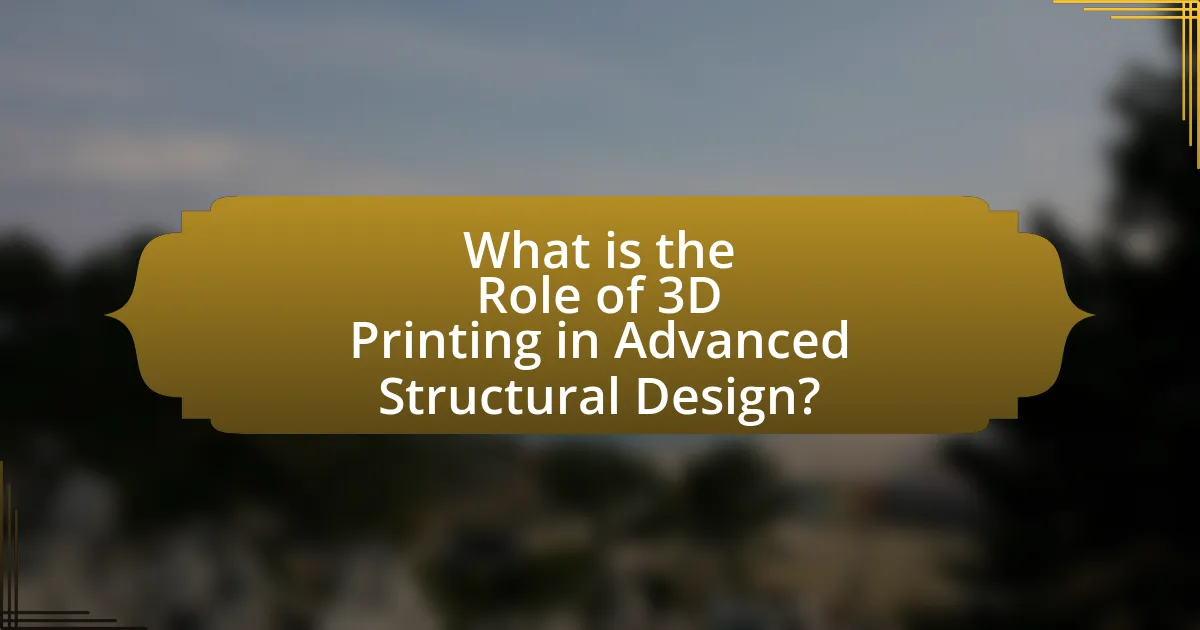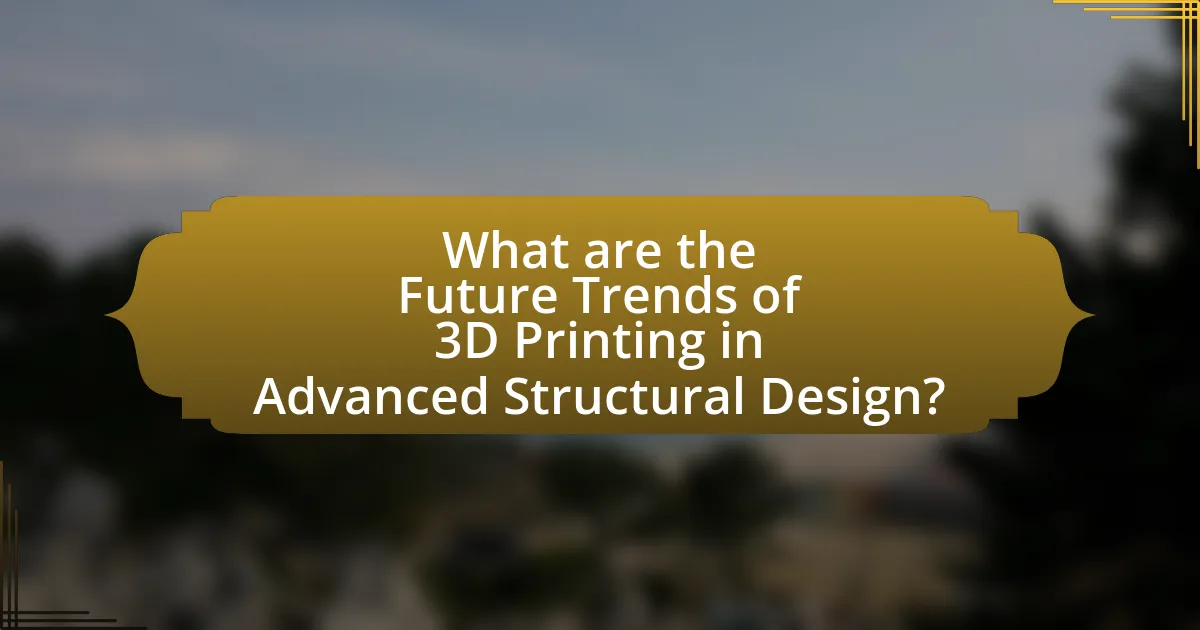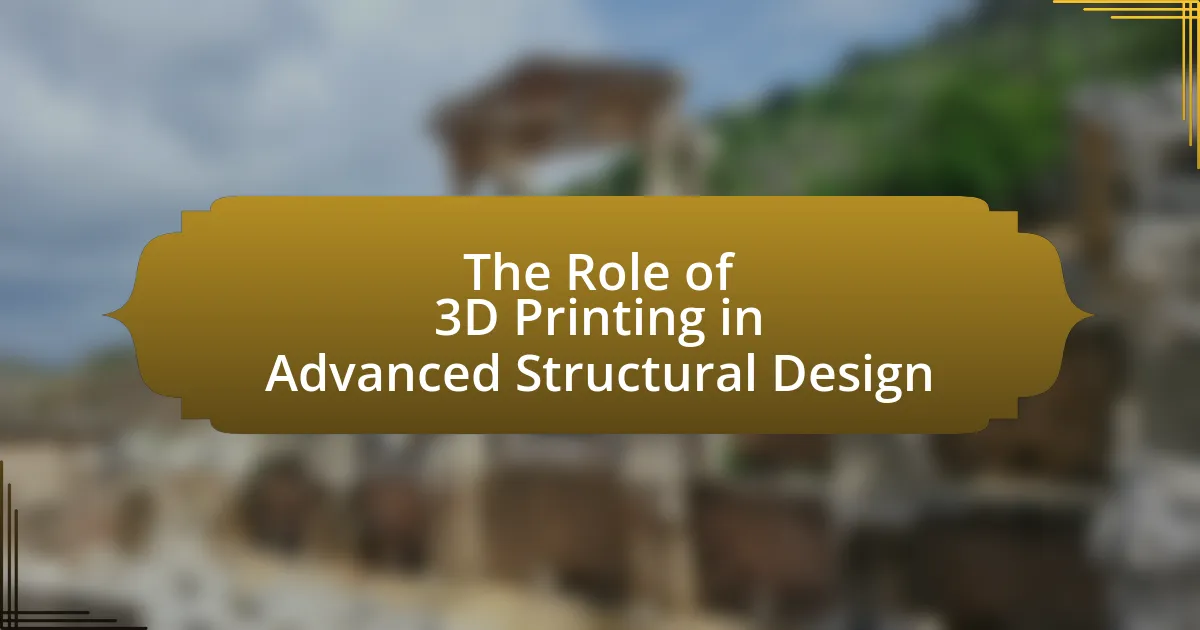The article focuses on the significant role of 3D printing in advanced structural design, highlighting its ability to create complex geometries that traditional manufacturing methods cannot achieve. It discusses how 3D printing enhances design flexibility, reduces material waste by up to 90%, and accelerates production timelines by as much as 70%. Key technologies involved include Fused Deposition Modeling (FDM), Stereolithography (SLA), and Selective Laser Sintering (SLS), each contributing to innovative structural solutions. The article also addresses the integration of 3D printing in sustainable design practices, the challenges it overcomes in traditional methods, and the future trends shaping its application in construction and engineering.

What is the Role of 3D Printing in Advanced Structural Design?
3D printing plays a crucial role in advanced structural design by enabling the creation of complex geometries that traditional manufacturing methods cannot achieve. This technology allows for the rapid prototyping and production of customized components, which enhances design flexibility and reduces material waste. For instance, structures can be optimized for weight and strength through lattice designs, which are easily fabricated using 3D printing techniques. Additionally, studies have shown that 3D printing can decrease production time by up to 70%, significantly accelerating the design-to-manufacturing process.
How does 3D printing integrate with structural design processes?
3D printing integrates with structural design processes by enabling rapid prototyping and customization of complex geometries. This technology allows architects and engineers to create intricate designs that traditional manufacturing methods cannot achieve, thereby enhancing design flexibility. For instance, a study published in the journal “Additive Manufacturing” by D. W. Rosen and colleagues highlights that 3D printing can reduce material waste by up to 90% compared to conventional methods, which is crucial for sustainable design practices. Additionally, 3D printing facilitates iterative testing and modification of structural components, allowing for real-time adjustments based on performance feedback, ultimately leading to more efficient and innovative structural solutions.
What technologies are involved in 3D printing for structural applications?
The technologies involved in 3D printing for structural applications include Fused Deposition Modeling (FDM), Stereolithography (SLA), Selective Laser Sintering (SLS), and Digital Light Processing (DLP). FDM utilizes thermoplastic materials to create structures layer by layer, making it suitable for producing large-scale components. SLA employs a laser to cure liquid resin into solid parts, offering high precision and smooth finishes, ideal for intricate designs. SLS uses a laser to fuse powdered materials, such as nylon or metal, allowing for complex geometries and strong parts. DLP, similar to SLA, uses a digital light projector to cure resin, enabling faster production times while maintaining detail. Each of these technologies has been validated through extensive use in industries such as aerospace, automotive, and construction, demonstrating their effectiveness in creating durable and functional structural components.
How does 3D printing influence design flexibility and creativity?
3D printing significantly enhances design flexibility and creativity by allowing for complex geometries and customized solutions that traditional manufacturing methods cannot achieve. This technology enables designers to create intricate structures with varying materials and properties, facilitating innovative designs tailored to specific functional requirements. For instance, a study published in the journal “Additive Manufacturing” highlights that 3D printing can produce lightweight lattice structures that optimize material usage while maintaining strength, showcasing the potential for creative engineering solutions. Additionally, the rapid prototyping capabilities of 3D printing allow for iterative design processes, enabling designers to quickly test and modify their ideas, further fostering creativity in structural design.
What are the key advantages of using 3D printing in structural design?
The key advantages of using 3D printing in structural design include enhanced design flexibility, reduced material waste, and accelerated construction timelines. Enhanced design flexibility allows architects and engineers to create complex geometries that are difficult or impossible to achieve with traditional methods. For instance, 3D printing enables the production of intricate lattice structures that optimize strength-to-weight ratios. Reduced material waste is achieved through additive manufacturing processes, which only use the material necessary for the design, minimizing excess. According to a study by the Massachusetts Institute of Technology, 3D printing can reduce material waste by up to 90% compared to conventional subtractive manufacturing techniques. Accelerated construction timelines result from the ability to produce components on-site and the potential for rapid prototyping, which can significantly shorten project durations. These advantages collectively contribute to more efficient and innovative structural design practices.
How does 3D printing reduce material waste in construction?
3D printing reduces material waste in construction by utilizing additive manufacturing techniques that build structures layer by layer, which minimizes excess material usage. Traditional construction methods often involve cutting and shaping materials, leading to significant waste; however, 3D printing allows for precise material placement according to design specifications, resulting in up to 60% less waste compared to conventional methods. This efficiency is supported by studies indicating that 3D printing can optimize material usage through computer-aided design, ensuring that only the necessary amount of material is used for each component.
What cost benefits does 3D printing provide in structural projects?
3D printing provides significant cost benefits in structural projects by reducing material waste and labor costs. Traditional construction methods often result in excess material usage, whereas 3D printing utilizes only the necessary amount of material, leading to a reduction in waste by up to 90%. Additionally, 3D printing can streamline the construction process, allowing for faster production times and less reliance on skilled labor, which can decrease labor costs by approximately 30%. These efficiencies not only lower overall project expenses but also enable more innovative designs that can be produced at a lower cost compared to conventional methods.

How is 3D Printing Transforming Traditional Structural Design Methods?
3D printing is transforming traditional structural design methods by enabling rapid prototyping and customization of complex geometries that were previously difficult or impossible to achieve. This technology allows architects and engineers to create intricate designs with reduced material waste and shorter production times. For instance, a study by the Massachusetts Institute of Technology demonstrated that 3D printing can reduce the time required for creating structural components by up to 70%, while also minimizing costs associated with traditional manufacturing processes. Additionally, 3D printing facilitates the use of innovative materials, such as bio-based plastics and composites, which can enhance the sustainability and performance of structures.
What challenges does traditional structural design face that 3D printing addresses?
Traditional structural design faces challenges such as limitations in complexity, material waste, and high costs, which 3D printing effectively addresses. Traditional methods often restrict the design to simpler geometries due to manufacturing constraints, while 3D printing allows for intricate and optimized structures that can enhance performance. Additionally, conventional construction generates significant material waste, whereas 3D printing utilizes additive manufacturing techniques that minimize waste by building objects layer by layer. Furthermore, the cost of producing custom components in traditional design can be prohibitive; 3D printing reduces these costs by enabling on-demand production and reducing the need for extensive tooling.
How does 3D printing enhance prototyping and testing in structural design?
3D printing enhances prototyping and testing in structural design by enabling rapid production of complex geometries and customized components. This technology allows designers to create physical models quickly, facilitating iterative testing and modifications based on real-world performance. For instance, a study by Wohlers Associates in 2021 highlighted that 3D printing can reduce prototyping time by up to 90%, allowing for faster feedback loops and improved design accuracy. Additionally, the ability to produce lightweight structures with intricate designs leads to better material efficiency and performance optimization in structural applications.
What role does 3D printing play in sustainable design practices?
3D printing significantly contributes to sustainable design practices by enabling the production of complex geometries with minimal material waste. This additive manufacturing process allows for precise material usage, reducing excess and scrap compared to traditional subtractive methods. For instance, a study published in the journal “Additive Manufacturing” highlights that 3D printing can reduce material consumption by up to 90% in certain applications. Additionally, 3D printing facilitates the use of eco-friendly materials, such as biodegradable plastics and recycled composites, further enhancing sustainability in design.
How are architects and engineers adapting to 3D printing technologies?
Architects and engineers are adapting to 3D printing technologies by integrating additive manufacturing into their design and construction processes. This adaptation allows for the creation of complex geometries that traditional methods cannot achieve, enhancing design flexibility and innovation. For instance, the use of 3D printing enables rapid prototyping, which accelerates the design iteration process, allowing architects to visualize and modify structures quickly. Additionally, engineers are utilizing 3D printing for producing custom components and materials, which can reduce waste and lower costs. A notable example is the use of 3D-printed concrete in construction, which has been shown to decrease material usage by up to 60% compared to conventional methods. This shift not only improves efficiency but also supports sustainable building practices.
What skills are necessary for professionals to effectively use 3D printing in design?
Professionals need skills in CAD software, material science, and an understanding of 3D printing technologies to effectively use 3D printing in design. Proficiency in CAD software allows designers to create detailed 3D models, which are essential for accurate printing. Knowledge of material science is crucial for selecting appropriate materials that can withstand the intended application and environmental conditions. Additionally, understanding various 3D printing technologies, such as FDM, SLA, and SLS, enables professionals to choose the right method for their specific design requirements, ensuring optimal results.
How are educational institutions incorporating 3D printing into their curricula?
Educational institutions are incorporating 3D printing into their curricula by integrating it into design, engineering, and manufacturing courses. This integration allows students to engage in hands-on projects that enhance their understanding of advanced structural design principles. For instance, universities like MIT and Stanford have established dedicated labs where students can create prototypes and models using 3D printers, fostering innovation and practical skills. Additionally, research indicates that 3D printing enhances learning outcomes by enabling experiential learning, as evidenced by a study published in the Journal of Engineering Education, which found that students who utilized 3D printing in their projects demonstrated improved problem-solving abilities and creativity.

What are the Future Trends of 3D Printing in Advanced Structural Design?
The future trends of 3D printing in advanced structural design include increased use of sustainable materials, enhanced design complexity, and integration with digital twin technology. Sustainable materials, such as bio-based and recycled filaments, are gaining traction as industries seek to reduce their environmental impact. Enhanced design complexity allows for the creation of intricate geometries that traditional manufacturing methods cannot achieve, leading to more efficient structures. Additionally, the integration of digital twin technology enables real-time monitoring and optimization of structures, improving performance and maintenance. These trends are supported by advancements in material science and software development, which facilitate the adoption of 3D printing in various sectors, including construction and aerospace.
How is the market for 3D printing in construction expected to evolve?
The market for 3D printing in construction is expected to grow significantly, driven by advancements in technology and increasing demand for sustainable building practices. According to a report by MarketsandMarkets, the 3D printing construction market is projected to reach $1.5 billion by 2024, growing at a compound annual growth rate (CAGR) of 14.5% from 2019. This growth is fueled by the ability of 3D printing to reduce material waste, lower labor costs, and enable complex designs that traditional construction methods cannot achieve. Additionally, the integration of automation and robotics in 3D printing processes is anticipated to enhance efficiency and scalability, further propelling market expansion.
What innovations are on the horizon for 3D printing technologies?
Innovations on the horizon for 3D printing technologies include advancements in materials, such as bio-based and multi-material printing, which enhance the versatility and application range of 3D printing. For instance, researchers are developing new polymers and composites that improve strength and durability, enabling the production of more complex structures. Additionally, the integration of artificial intelligence in 3D printing processes is expected to optimize design and manufacturing efficiency, allowing for real-time adjustments during printing. Furthermore, advancements in large-scale 3D printing techniques, such as robotic arms and gantry systems, are set to revolutionize construction and infrastructure development by enabling the rapid fabrication of entire buildings. These innovations are supported by ongoing research and development efforts in both academic and industrial settings, highlighting the potential for 3D printing to transform advanced structural design.
How will regulatory frameworks adapt to the rise of 3D printing in construction?
Regulatory frameworks will adapt to the rise of 3D printing in construction by developing specific guidelines and standards that address the unique challenges posed by this technology. As 3D printing becomes more prevalent, regulatory bodies will likely establish safety protocols, material specifications, and quality assurance measures to ensure structural integrity and compliance with building codes. For instance, the International Organization for Standardization (ISO) has already begun working on standards related to additive manufacturing, which will influence how regulations are shaped. Additionally, jurisdictions may implement pilot programs to test 3D-printed structures, allowing for real-world data to inform future regulations. This proactive approach will help integrate 3D printing into existing construction practices while ensuring public safety and environmental considerations are met.
What best practices should be followed when implementing 3D printing in structural design?
When implementing 3D printing in structural design, best practices include optimizing designs for additive manufacturing, selecting appropriate materials, and conducting thorough testing. Optimizing designs involves creating geometries that leverage the unique capabilities of 3D printing, such as complex shapes and lightweight structures, which can enhance performance and reduce material waste. Selecting materials is crucial; using materials specifically designed for 3D printing, such as thermoplastics or metal alloys, ensures structural integrity and durability. Conducting thorough testing, including simulations and physical prototypes, validates the design’s performance under real-world conditions, ensuring safety and reliability. These practices are supported by industry standards and case studies demonstrating successful applications of 3D printing in structural engineering.
How can teams ensure quality and safety in 3D printed structures?
Teams can ensure quality and safety in 3D printed structures by implementing rigorous quality control measures throughout the printing process. This includes conducting material testing to verify the properties of the filament or resin used, ensuring that it meets industry standards for strength and durability. Additionally, teams should utilize advanced monitoring technologies, such as in-situ sensors, to track the printing parameters in real-time, allowing for immediate adjustments if deviations occur.
Furthermore, post-processing techniques, such as heat treatment or surface finishing, can enhance the mechanical properties of the printed structures. Regular inspections and adherence to established safety protocols during both the printing and assembly phases are crucial to mitigate risks. Research indicates that following these practices can significantly reduce the likelihood of structural failures, as evidenced by studies showing that 3D printed components can achieve comparable strength to traditionally manufactured parts when proper quality assurance is applied.
What common pitfalls should be avoided in 3D printing projects?
Common pitfalls to avoid in 3D printing projects include inadequate preparation of the 3D model, improper calibration of the printer, and neglecting material properties. Inadequate preparation can lead to design flaws, such as non-manifold edges, which can cause printing errors. Proper calibration of the printer is essential; misalignment can result in poor layer adhesion and dimensional inaccuracies. Additionally, neglecting the specific properties of the printing material, such as temperature sensitivity and strength, can lead to structural failures in the final product. These pitfalls can significantly impact the quality and functionality of 3D printed structures, making attention to detail crucial in the design and printing process.

Leave a Reply